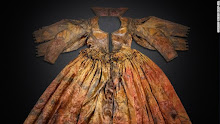 |
Costume Exhibition at Winterthur Museum
Sept 9, 2023 - January 7, 2024
“In
1964, The Saturday Evening Post referred to fashion designer Ann Lowe as
‘Society’s Best-Kept Secret.’ Although Lowe had been designing couture-quality
gowns for America’s most prominent debutantes, heiresses, actresses, and
society brides—including Jacqueline Kennedy, Olivia de Havilland, and Marjorie
Merriweather Post—for decades, she remained virtually unknown to the wider
public. Since then, too little recognition has been given to her influence on
American fashion.
“Ann Lowe’s recently emerging visibility as a
designer stands in contrast to much of her career and the countless
unrecognized Black dressmakers and designers who have contributed to American
fashion for generations, including her own grandmother and mother. She blazed a
path for others to follow and her legacy is still felt in fashion culture.” [Continue reading exhibition text.] |
 |
Jacqueline Kennedy in her wedding gown
designed by Ann Lowe, 1953 |
My 2011 article published in Atlanta's Season magazine, "What Does a Fashion Icon Wear to Her Own Wedding/s," shares what Jacqueline Bouvier Kennedy really wanted her wedding gown to look like! Here's an excerpt:
During the presidential state
visit to France
in the spring of 1961, “more than a million Parisians lined the parade route,
chanting ‘Jacqui! Jacqui!’ as the Kennedys entered Paris,” Kathleen Craughwell-Varda recalled in
Looking for Jackie: American Fashion
Icons. As the charismatic wife of the U.S. president, Jackie Kennedy’s chic,
elegant style—copied by women around the world—even won over the toughest
fashion critics...the French!
However, the woman who revolutionized
a stodgy fashion industry and headlined the best-dressed list for years had not worn the wedding gown of her choice.
Jacqueline (Jock-leen) Bouvier was a young bride in 1953 when it was typical
for the bride’s mother to plan the wedding, dictate or greatly influence what her
daughter would wear (and frequently whom she would marry), and basically run the
show.
Of course, the headstrong Jackie
was not just any bride of the fifties. She was the future wife of one of the
wealthiest men in the country and one whose father had great political plans
for his oldest son’s future. So not only did the Newport wedding become a huge Kennedy-orchestrated,
high-society spectacle (instead of the small affair the bride and her family
wanted), but the bride’s gown reflected what the groom requested. “Jackie wanted to wear a sleek, modern gown, in
keeping with the pared-down style she preferred,” Craughwell-Varda explained,
“but Jack persuaded her to select something more traditional and
old-fashioned.”
The bride’s mother chose Ann
Lowe, an African American designer in New
York City “who catered to society women.” From her
workshop on Lexington Avenue,
the designer created an elaborate gown of ivory silk taffeta with a portrait
neckline, off-the-shoulder cap sleeves and big ruffled swirls on the full
skirt. Jackie also wore the long rose point lace veil worn by her mother and
grandmother attached to their wax orange blossom wreath. Perhaps the only time the
glamorous Jackie looked “traditional.” (If Jackie had gotten to choose, don’t
you think her gown would have been very Givenchy-ish? And with all that Kennedy
money at her young fingertips, perhaps she would have gone directly to the master
French couturier himself!)
 |
Jacqueline Kennedy wearing Oleg Cassini,
appointed as her "exclusive couturier,"
Elysee Palace reception in Paris,1961 |

















.jpg)





























